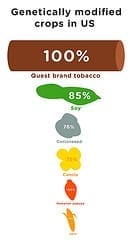
Superweeds? Suicides? Stealthy genes? The true, the false and the still unknown about transgenic crops
In the pitched debate over genetically modified (GM) foods and crops, it can be hard to see where scientific evidence ends and dogma and speculation begin. In the nearly 20 years since they were first commercialized, GM crop technologies have seen dramatic uptake. Advocates say that they have increased agricultural production by more than US$98 billion and saved an estimated 473 million kilograms of pesticides from being sprayed. But critics question their environmental, social and economic impacts.
Researchers, farmers, activists and GM seed companies all stridently promote their views, but the scientific data are often inconclusive or contradictory. Complicated truths have long been obscured by the fierce rhetoric. “I find it frustrating that the debate has not moved on,” says Dominic Glover, an agricultural socioeconomist at Wageningen University and Research Center in the Netherlands. “The two sides speak different languages and have different opinions on what evidence and issues matter,” he says.
Here, Nature takes a look at three pressing questions: are GM crops fuelling the rise of herbicide-resistant ‘superweeds’? Are they driving farmers in India to suicide? And are the foreign transgenes in GM crops spreading into other plants? These controversial case studies show how blame shifts, myths are spread and cultural insensitivities can inflame debate.
GM crops have bred superweeds: True
Jay Holder, a farming consultant in Ashburn, Georgia, first noticed Palmer amaranth (Amaranthus palmeri) in a client’s transgenic cotton fields about five years ago. Palmer amaranth is a particular pain for farmers in the southeastern United States, where it outcompetes cotton for moisture, light and soil nutrients and can quickly take over fields.
Since the late 1990s, US farmers had widely adopted GM cotton engineered to tolerate the herbicide glyphosate, which is marketed as Roundup by Monsanto in St Louis, Missouri. The herbicide–crop combination worked spectacularly well — until it didn’t. In 2004, herbicide-resistant amaranth was found in one county in Georgia; by 2011, it had spread to 76. “It got to the point where some farmers were losing half their cotton fields to the weed,” says Holder.
Some scientists and anti-GM groups warned that GM crops, by encouraging liberal use of glyphosate, were spurring the evolution of herbicide resistance in many weeds. Twenty-four glyphosate-resistant weed species have been identified since Roundup-tolerant crops were introduced in 1996. But herbicide resistance is a problem for farmers regardless of whether they plant GM crops.
The Latest Bing News on:
Genetically Modified Crops
- Analysing the GMO crops fiascoon May 6, 2024 at 4:59 pm
In early February, the chairman of Global Prolife Alliance (GPA), Dr. Philip Njemanze, another voice calling for total ban on genetically modified foods wrote a letter to the National Assembly urging ...
- GM Crops: Activists raise concern over Golden Rice, Bt Brinjalon May 6, 2024 at 9:36 am
Activists from several organizations have raised concerns about the genetically modified (GM) crops Golden Rice and Bt Brinjal, calling upon the government to refrain from allowing their cultivation ...
- Gov’t told: Genetically modified crops to feed populationon May 6, 2024 at 3:06 am
Five major business groups urged the government to prioritize support for biotech crops amid a recent court ruling stopping the commercial propagation of genetically modified rice and ...
- The Philippines bans some genetically modified foodson May 2, 2024 at 6:16 am
The Philippine government says the golden-rice ban will have “significant” implications for food security. For every year that golden-rice cultivation is delayed, thousands in Asia will die, says ...
- Devex Dish: The roots of India’s anemia crisis may lie in its cropson May 1, 2024 at 7:14 am
Experts are struggling to meet an emergency driven by a combination of poverty, genetically modified foods, and climate change. Plus, famine appears all but inevitable in Gaza and Sudan.
- Genetically Modified Cell Wall Thickness Improves Photosynthetic Efficiency in the Fieldon April 30, 2024 at 9:00 am
An engineered increase in mesophyll conductance, by reducing the thickness of cell walls, results in improved photosynthetic efficiency.
- Genetically modified golden rice may yet succeed in the Philippineson April 29, 2024 at 5:02 am
A court in the Philippines revoked the permit to grow rice genetically modified to boost vitamin A, but the government is expected to appeal against the decision ...
- What is Golden Rice? Philippine Court Blocks Commercial Production of Genetically Modified Rice Over Safety Concernson April 27, 2024 at 6:24 am
Philippine court ruling blocks commercial production of genetically modified golden rice and BT brinjal, citing safety concerns. Decision sparks debate over the safety and future of genetically modifi ...
- Stopping GMO crops may cause ‘more harm than good’ – scientistson April 26, 2024 at 10:34 pm
A recent court decision halting the production of the genetically modified crops Golden Rice and Bt (Bacillus thuringiensis) eggplant may impact on the country’s food security and may cause ...
- Philippine court blocks genetically modified golden rice production over safety fearson April 25, 2024 at 11:53 am
"This decision is a monumental win for Filipino farmers and Filipino people who have for decades stood up against genetically modified crops," Greenpeace Southeast Asia campaigner Wilhelmina Pelegrina ...
The Latest Google Headlines on:
Genetically Modified Crops
[google_news title=”” keyword=”Genetically Modified Crops” num_posts=”10″ blurb_length=”0″ show_thumb=”left”]
The Latest Bing News on:
Herbicide resistance
- New ways to defeat weedson May 8, 2024 at 12:00 am
While effective herbicide options to control the most challenging weeds dwindle, industry is increasing efforts to discover new technologies to better control weeds. While a new herbicide such as ...
- Into the weeds: 2024 in previewon May 7, 2024 at 11:50 pm
The past few seasons have been a challenging time for farmers on the Canadian Prairies. Extreme heat, lack of precipitation and steep increases in ...
- 12 Most Common Weeds and How To Get Rid of Themon May 7, 2024 at 10:23 pm
When to keep and when to remove some of the fastest-growing U.S. weeds. While some weeds are a nuisance, some feed people and pollinators.
- Court ruling could trigger environmental assessment for Kauai seed production projecton May 7, 2024 at 8:42 pm
A Kauai seed production company may be forced to do an environmental assessment because of a ruling from the state Intermediate Court of Appeals.Environmentalists hope it will force the state to ...
- EPA takes comments on XtendiMax labelon May 7, 2024 at 1:25 pm
The Environmental Protection Agency is taking public comments on a 2025 registration and label for a Bayer low-volatility herbicide formerly known as XtendiMax. Bayer submitted a new registration for ...
- A New Tactic For The War With Weedson May 7, 2024 at 7:00 am
Herbicide tolerant weeds are an increasing issue that interferes with the progress that has been made to avoid mechanical tillage and protect soil health ...
- ADAMA Set to Bring Innovation to the European Cereal Herbicide Segment with the Introduction of EDAPTIS®on May 6, 2024 at 4:35 am
ADAMA Ltd (SZSE 000553), a leading global crop protection company, today announced the first registration of EDAPTIS® in Poland. EDAPTIS® is a ready-to-use solution that provides broad-spectrum ...
- Tom Lounsbury: Autumn olive is an invasive with staying poweron May 5, 2024 at 5:00 pm
My goal is to compare how the fields refurbish themselves according to the method used. Autumn olive is also quite herbicide-resistant, usually requiring harsh chemicals to effectively kill it, ...
- Urine sample study finds industrial toxin in adolescents: 'There is a lot of exposure'on May 2, 2024 at 7:00 pm
A new study revealed that a shockingly high number of adolescents in an agricultural area of Ecuador have high concentrations of glyphosate — the active ingredient in the popular weed killer Roundup — ...
- For better weed management, deplete the seed bankon April 23, 2024 at 8:28 am
Another way to shrink your weed seed bank is to create more suitable habitats for the birds, insects and earthworms that eat them. Use cover crops and other tools to manage soil nutrient levels. The ...
The Latest Google Headlines on:
Herbicide resistance
[google_news title=”” keyword=”herbicide resistance” num_posts=”10″ blurb_length=”0″ show_thumb=”left”]










